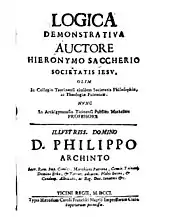Giovanni Girolamo Saccheri
Giovanni Girolamo Saccheri (Italian pronunciation: [dʒoˈvanni dʒiˈrɔːlamo sakˈkɛːri]; 5 September 1667 – 25 October 1733) was an Italian Jesuit priest, scholastic philosopher, and mathematician.
| Part of a series on the |
| Society of Jesus |
|---|
 |
| History |
| Hierarchy |
| Spirituality |
| Works |
| Notable Jesuits |
|
|


Saccheri was born in Sanremo. He entered the Jesuit order in 1685 and was ordained as a priest in 1694. He taught philosophy at the University of Turin from 1694 to 1697 and philosophy, theology and mathematics at the University of Pavia from 1697 until his death. He was a protégé of the mathematician Tommaso Ceva and published several works including Quaesita geometrica (1693), Logica demonstrativa (1697), and Neo-statica (1708).
Geometrical work
He is primarily known today for his last publication, in 1733 shortly before his death. Now considered the second work in non-Euclidean geometry, Euclides ab omni naevo vindicatus (Euclid Freed of Every Flaw) languished in obscurity until it was rediscovered by Eugenio Beltrami, in the mid-19th century.
Many of Saccheri's ideas have a precedent in the 11th-century Persian polymath Omar Khayyám's Discussion of Difficulties in Euclid (Risâla fî sharh mâ ashkala min musâdarât Kitâb 'Uglîdis), a fact ignored in most Western sources until recently.
It is unclear whether Saccheri had access to that work in translation or he developed his ideas independently. The Saccheri quadrilateral is now sometimes referred to as the Khayyam-Saccheri quadrilateral.
The intent of Saccheri's work was ostensibly to establish the validity of Euclid by means of a reductio ad absurdum proof of any alternative to Euclid's parallel postulate. To do so, he assumed that the parallel postulate was false and attempted to derive a contradiction.
Since Euclid's postulate is equivalent to the statement that the sum of the internal angles of a triangle is 180°, he considered both the hypothesis that the angles add up to more or less than 180°.
The first led to the conclusion that straight lines are finite, contradicting Euclid's second postulate. So Saccheri correctly rejected it. However, the principle is now accepted as the basis of elliptic geometry, where both the second and fifth postulates are rejected.
The second possibility turned out to be harder to refute. In fact he was unable to derive a logical contradiction and instead derived many non-intuitive results; for example that triangles have a maximum finite area and that there is an absolute unit of length. He finally concluded that: "the hypothesis of the acute angle is absolutely false; because it is repugnant to the nature of straight lines". Today, his results are theorems of hyperbolic geometry.
There is some minor argument on whether Saccheri really meant that, as he published his work in the final year of his life, came extremely close to discovering non-Euclidean geometry and was a logician. Some believe Saccheri concluded as he did only to avoid the criticism that might come from seemingly-illogical aspects of hyperbolic geometry.
See also
- Saccheri–Legendre theorem
- Hyperbolic geometry
- Parallel postulate
- List of Jesuit scientists
- List of Roman Catholic cleric–scientists
References
- Martin Gardner, Non-Euclidean Geometry, Chapter 14 of The Colossal Book of Mathematics, W. W.Norton & Company, 2001, ISBN 0-393-02023-1
- M. J. Greenberg, Euclidean and Non-Euclidean Geometries: Development and History, 1st ed. 1974, 2nd ed. 1980, 3rd ed. 1993, 4th edition, W. H. Freeman, 2008.
- Girolamo Saccheri, Euclides Vindicatus (1733), edited and translated by G. B. Halsted, 1st ed. (1920);[1] 2nd ed. (1986), review by John Corcoran: Mathematical Reviews 88j:01013, 1988.
- Emch, Arnold (1922). "Review of Giralamo Saccheri's Euclides Vindicatus, edited and translated by G. B. Halsted" (PDF). Bull. Amer. Math. Soc. 28 (3): 131–132. doi:10.1090/s0002-9904-1922-03514-8.
External links
- O'Connor, John J.; Robertson, Edmund F., "Giovanni Girolamo Saccheri", MacTutor History of Mathematics archive, University of St Andrews.
- Roero, Clara Silvia (2017). "SACCHERI, Giovanni Girolamo". Dizionario Biografico degli Italiani, Volume 89: Rovereto–Salvemini (in Italian). Rome: Istituto dell'Enciclopedia Italiana.